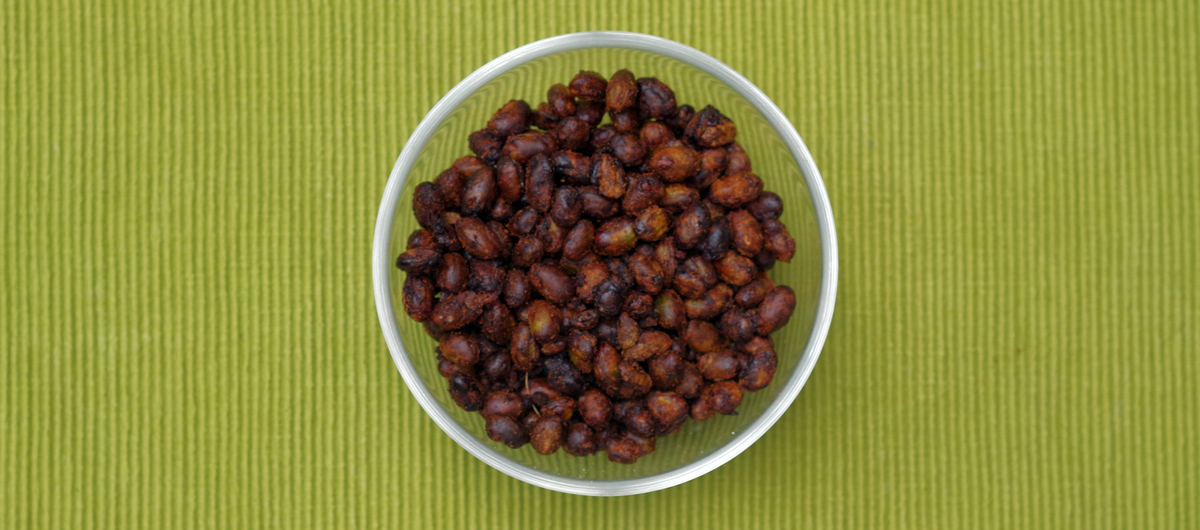Yoga Kitchen – Simple, healthy, and plant-based
Nutritional value hinges on preparation
Edamame are green soybeans. Young green soybeans are also called mukimame.
Edamame beans are not readily available everywhere, but you can find them more and more. In organic shops and Oriental supermarkets most easily. Usually deep frozen, and stripped of their pods. And if you have a choice between with or without pods, do without. Because the fibrous, rough pods are not so tasty.
Edamame beans are not only very healthy, but also super tasty. Of all the beans, they are also the quickest to prepare.
Below are two ideas for an edamame bean-based snack. These immediately give food for thought. About how best to handle preparing legumes and food in general.
Recipe 1: Edamame with cheese and onion flavour
This 100% plant-based recipe uses no cheese at all, of course. However, by cleverly combining some purely plant-based ingredients, you do get something reminiscent of the taste of cheese and onions.
What ingredients do you need?
- 250g frozen edamame beans, shelled
- one tablespoon of nutritional yeast flakes
- half a teaspoon of onion powder or onion grits
- some black pepper
- a quarter teaspoon of sea salt
- half a teaspoon of (apple cider) vinegar
- and finally half a teaspoon of olive oil
This is how to prepare them
- Cook the edamame beans in lightly salted water for 5-6 minutes
- Drain them and rinse briefly
- Combine all the other ingredients for the marinade
- Mix the beans into the marinade
Done!
Recipe 2: Grilled spicy Edamame beans
The big difference here is that the marinated beans are grilled in the oven or in an airfryer at 180 to 190 °C.
What ingredients do you need?
- 250g frozen edamame beans, shelled
- a teaspoon of red paprika
- a pinch of cayenne pepper
- one teaspoon of onion powder or onion grits
- another teaspoon of garlic powder
- a tablespoon of melted coconut oil
- and finally a teaspoon of sea salt
This is how to prepare these appetisers with edamame
- Heat the oven to 190 °C
- Mix the edamame beans and all the ingredients well
- Spread them out on a baking tray lined with baking paper for the oven or on the grid of an airfryer
- Bake for about 30 minutes until brown and crispy
The taste test
I personally fall like a log for the edamame beans in the first recipe. A heavenly flavour with notes of salt, acid and umami with the creaminess of the olive oil. The beans have a firm bite and are juicy. They also look like fresh, firm beans.
Recipe number two sums up very well what flavour and bite is popular in our Western snacking and fast-food culture. It is the sought-after combination of salty, spicy, dry and crunchy. The beans crack just like classic brittle roasted peanuts. Many people will love this and won’t be able to stay away from it. Easily available fast-food peanut snacks are often fried in a crust of oil, salt, sugar and flour. In contrast, these roasted edamame snacks have the advantage of being exempt of sugar, flavour enhancers or food preservatives.
But they look nothing like the fresh, moist beans they were at the beginning of the run. They are now dried out and brown …
The health verdict
Put yourself in the place of your stomach and digestive system for a moment. Which is easiest to digest: the short-cooked beans that have retained their natural moisture content? Or the hard, dry and now browned beans? After all, for these latter, our intestines need extra moisture to digest them.
And which is healthiest: the unheated olive oil or the coconut oil heated to 190 °C?
Recipe number one wins with flying colours!
Eat your food as little processed as possible
Many cookbooks are full of recipes that seem to only give importance to taste, feel and appearance of our food. Rarely is there any mention of health, digestibility or the ease with which the dish can be absorbed by our metabolism.
The same goes for most products displayed in our food shops and supermarkets.
Not infrequently, good ingredients lose much, if not all, of their nutritional value and energetic potential just by the method of preparation chosen. Either by the way they are processed or altered.
What are the healthiest cooking techniques?
In the world of health philosophies, people pretty much agree on one thing. Namely that processed, especially extremely processed foods can be downright harmful in the long run.
Not all foods can be eaten raw. Legumes or certain starchy root vegetables, for example, have to be cooked. On the other hand, some foods are sometimes even nutritionally enhanced after heating. This is the case for steamed or boiled carrots compared to raw carrots, for instance. Fermentation techniques can also change the taste and nutritional value of vegetables for the better.
And in our own kitchen, too, we can very consciously choose those recipes that use short, gentle cooking techniques. Because these involve the fewest losses.
Below are some cooking techniques classified from softer to harder:
- steaming (over boiling water)
- blanching
- boiling
- steaming (in a small amount of water and fat)
- baking
- braising
- broiling
- stir frying (wok)
- grilling
- deep frying
- popping
- blackening
The shorter the food item is heated and the softer the cooking technique, the greater the remaining nutritional value.
Edamame beans, frozen, unprepared, per 100 g product
| Energy | Carboh. | Sugars | Fat | Sat. Fat | Protein | Fibre | Salt |
|---|---|---|---|---|---|---|---|
| 507 kJ/121 kcal | 8,9 g | 2,2 g | 5,2 g | 0,6 g | 11,9 g | 5,2 g | 0,03 g |
Participate in our cooking classes:
Read more about plant-based nutrition and health:
Read more about plant-based food
Find out about yoga and yoga classes in Schaerbeek:
Check out our yoga classes here:


